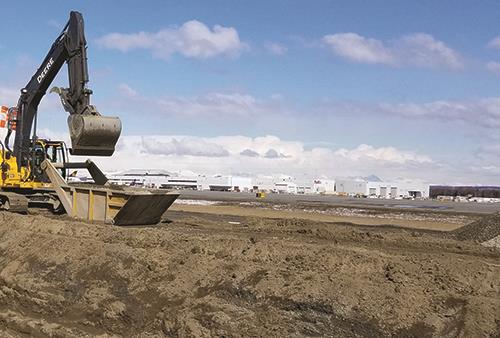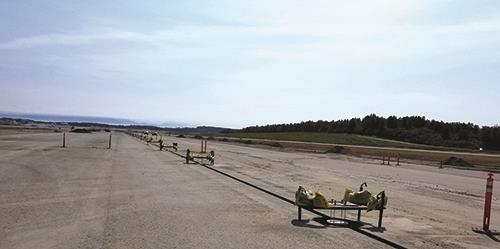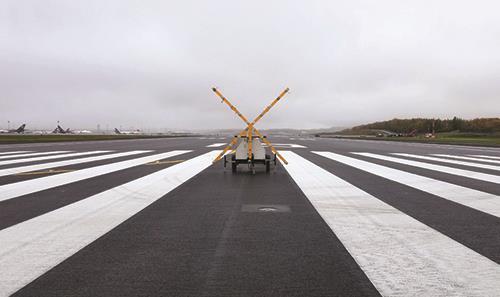It’s common for airports to uncover unexpected challenges such as unmarked utilities, protected wildlife or even buried aircraft and other military surplus during airfield projects. At Ted Stevens Anchorage International (ANC), the ground beneath the airfield literally shook during its recent runway rehabilitation.
It’s common for airports to uncover unexpected challenges such as unmarked utilities, protected wildlife or even buried aircraft and other military surplus during airfield projects. At Ted Stevens Anchorage International (ANC), the ground beneath the airfield literally shook during its recent runway rehabilitation.
But even a significant earthquake didn’t derail the major project. Officials were determined to ensure that the airport’s main north/south runway (15-33) could continue to safely handle its always-busy cargo operations. As a gateway for cargo planes traveling between North America and Asia, ANC is the fifth-busiest airport in the world in terms of cargo throughput, behind only Hong Kong International, Memphis International, Shanghai Pudong and Incheon International in South Korea.
To accommodate this traffic, the runway had to be able to handle newer Aircraft Design Group (ADG) VI equipment, such as the Boeing 747-8F and Airbus 380-800. This April, an Antonov An-225 Mriya, the world’s largest cargo aircraft, landed on Runway 15-33 and drew crowds of local spectators.
|
facts&figures Project: Runway Rehabilitation Location: Ted Stevens Anchorage Int’l Airport Project Scope: Crews widened & strengthened base of main north/south runway; moved thresholds at both ends; installed new LED lights; strengthened adjoining taxiways Project Cost: $68 million Funding: $59 million in Airport Improvement Program grants; $9 million airport funds Strategy: Improve runway to accommodate largest cargo jets Construction: May 2018 to Oct. 2019 2019 Passenger Volume: 5.7 million 2019 Flight Operations: 270,000 (48% cargo, 52% passenger) Passenger Destinations: 21 Cargo Destinations: 44 Project Engineer: Alaska DOT/Aviation Design Section Electrical Engineer: Stantec Pavement Contractor: Quality Asphalt & Paving Lighting Equipment Supplier: Airside Solutions/ADB SAFEGATE Electrical Contractor: NPC Energy Services Wedge Lock Washers: HEICO-LOCK PAPI & NAVAIDS Lighting: FAA NAVAIDS Engineering Center FAA Contractor: Burton Key Benefits: Accommodating largest jumbo jets; meeting FAA airfield standards; improving safety; reducing operational & maintenance costs |
Airport Manager Jim Szczesniak points out that several factors converged to make this project a necessity. “We get about 100 747 landings here every day, and many are the 747-8F cargo jets,” he explains. “UPS, one of our main clients, is taking delivery of more 747-8Fs in the near future, so we wanted to not only repave the surface of Runway 15-33, but strengthen its base to handle these larger, heavier planes.
“In addition, the FAA requested that we relocate the thresholds at both the southern (33) end of the runway as well as the northern (15) end. We also had to work on several taxiways.”
Besides Szczesniak, two of the other key officials involved in the planning and implementation of the project were John Johansen, the airport’s engineering, environmental and planning manager, and Jenelle Brinkman, an aviation design project manager for the State of Alaska Department of Transportation. Brinkman served as the lead engineer for the project.
“This project required that several jobs had to be accomplished simultaneously,” Brinkman says. “Taxiway Y, which runs parallel to Runway 15-33, and is just west of it, was reconstructed in 2017. Then, when 15-33 was being rebuilt in 2018 and 2019, we simultaneously worked on taxiway R, the second parallel taxiway to 15-33 just east of it.”
FAA requirements dictated several geometry changes for 15-33 and its interlinking taxiways. As a result, both ends of the runway were significantly altered. At the south end, the location of the runway end remained the same, but Brinkman and her team shifted the displaced threshold 200 feet to the north to remove the overlapping runway safety areas from runway 15-33 and runway 7L-25R (the main east-west runway below it). At the north end, project designers relocated the runway end 100 feet farther south to remove the displaced threshold.
Moving the threshold at the south end of the runway was especially important, because there was an overlapping safety area for both Runway 33 and Runway 7L-25R. “When maintenance had to clear snow on 15-33, the airport sometimes had to close 7L-25R as well while the snow removal equipment was in the overlapping safety areas. That is now no longer a problem,” Brinkman says.
Another key element of the construction was widening Runway 15-33 from 150 feet to 200 feet. In addition, crews installed LED lights on 15-33 and its connecting taxiways.
The runway’s newly strengthened asphalt base is now 15 inches deep and contains two different types of asphalt to accommodate larger, heavier jets.
The project also modified and improved several taxiways. Taxiway R, which runs parallel to 15-33 to the east, was extended farther north and bolstered with a new structural section. Its existing displaced threshold was removed. Improvements include utility adjustments, storm drain repairs and new LED lighting, markings and signs. The taxiway safety area also was widened 24 feet on each side to meet the design standard for ADG VI aircraft (a total width of 262 feet). Elevated taxiway edge lighting was relocated and replaced to match the related edge lines.
Finally, all of the interlinking taxiways that connect 15-33 to taxiway R were reconstructed to fit the new FAA Advisory Circular fillet geometry. Taxiway Q was reconfigured to allow access to the far end of Runway 15.

Intricate Coordination Needed
After three years of planning and design, and after all parties signed off on the plan, construction began in May 2018. Timing was everything, Szczesniak emphasizes. “We have a short construction season here, from late April to late September,” he says. “We decided to do this project during a two-year period. In 2018, we did the work on the runway’s southern end, and shortened it from 10,500 to 8,800 feet. That was still long enough to accommodate all of our passenger jets plus many of the cargo planes.”
 In spring 2019, however, the entire runway had to be closed to complete the project, and that caused consternation for jumbo jet pilots and some citizens in Anchorage. (ANC is located only 4 miles southwest of downtown Anchorage, and it borders Cook Inlet, an arm of the Gulf of Alaska.) “Normally, about 95% of the time, we route aircraft over the water, which serves as our western border. Normally, aircraft seldom go over the city. But during this project, we had to send all aircraft over the city itself,” explains Szczesniak.
In spring 2019, however, the entire runway had to be closed to complete the project, and that caused consternation for jumbo jet pilots and some citizens in Anchorage. (ANC is located only 4 miles southwest of downtown Anchorage, and it borders Cook Inlet, an arm of the Gulf of Alaska.) “Normally, about 95% of the time, we route aircraft over the water, which serves as our western border. Normally, aircraft seldom go over the city. But during this project, we had to send all aircraft over the city itself,” explains Szczesniak.
The temporary change prompted a few noise complaints from citizens, and pilots were not always enthusiastic about having to land and depart on 7R-25L and 7L-25R—the east/west runways. “We have strong winds from both the north and south depending on the season,” Szczesniak says. “747 captains don’t like landing huge planes in crosswinds, but we did not have a choice last year.”
Another challenge was that the big cargo carriers, including UPS, FedEx and DHL, schedule departures around the same time of day, so there was a regular parade of large aircraft taking off over residential areas, one after another.
Advance planning and communication were vital to keep all the stakeholders satisfied, Johansen states. “We have about 45 air carriers here—27 domestic and 18 international. We started planning this project three years in advance, and made sure we communicated what we were doing at every stage of the process,” he says. “With the shorter runway length during 2018, some cargo carriers going long distances had to reduce their loads in some cases.”
 The airport kept Anchorage residents and businesses informed about changes throughout the project via local news articles, postings at public events, presentations at city council meetings, a public meeting and a website. For the most part, complaints were minimal, says Szczesniak. Ironically, one local resident affected by the new routing was Brinkman herself. “I live at the south end of Anchorage, and when we had to close 15-33 in 2019, many of the planes took off to the east, and these huge jumbo jets flew right over my house as they departed,” she recalls. “But I couldn’t complain much, since I was involved in planning and designing this whole project.”
The airport kept Anchorage residents and businesses informed about changes throughout the project via local news articles, postings at public events, presentations at city council meetings, a public meeting and a website. For the most part, complaints were minimal, says Szczesniak. Ironically, one local resident affected by the new routing was Brinkman herself. “I live at the south end of Anchorage, and when we had to close 15-33 in 2019, many of the planes took off to the east, and these huge jumbo jets flew right over my house as they departed,” she recalls. “But I couldn’t complain much, since I was involved in planning and designing this whole project.”
 Johansen reports that most work went according to schedule during the two years of construction. The first phase, at the southern end of the runway, was completed right on schedule by fall 2018. Runway 15-33 remained open throughout the winter of 2018-2019, at its full length.
Johansen reports that most work went according to schedule during the two years of construction. The first phase, at the southern end of the runway, was completed right on schedule by fall 2018. Runway 15-33 remained open throughout the winter of 2018-2019, at its full length.
However, Mother Nature added an unexpected challenge in late 2018. On Nov. 30, the Anchorage area experienced a magnitude 7.1 earthquake. “There was some damage in the region, but we were lucky here at the airport, and did not incur any significant damage,” Johansen says. “None of the buildings or airside surfaces were damaged at all. Flights were delayed for maybe 15 minutes, as a precaution. It could have been a lot worse.”

New Lighting

During the project, Runway 15-33 and some of its adjoining taxiways received a complete new lighting system. Installation required advance planning and careful timing to coordinate with various stages of construction, says Lucas Schneller, the Stantec electrical engineer who led the lighting design.
“Stantec has done various projects for ANC for more than 15 years, so we were very familiar with the airport’s layout and the staff,” Schneller says. “We actually started planning for this project as part of the preceding Taxiway Y project. We developed a three-year plan for the electrical work, and this enabled a smooth transition between projects.”
The first stage was to replace the lights for Taxiway Y, which runs parallel to 15-33. That occurred when the taxiway was rebuilt in 2017.
For the 15-33 rebuild, Stantec added a lot of new equipment, including new light bases, conduits and circuitry, edge lights, LED centerline lights and signs for the runway and intersecting taxiways. New lighting for Taxiway R also was installed as part of a separate project happening concurrently.

“Our main challenges in planning were to keep all of the circuits connected when the runway and various taxiways were shut down, while also maintaining coordination with the ongoing FAA project,” Schneller says. “Fortunately, the project engineer and the electrical contractor, NPC Energy Services, did a great job with the construction. Everything went very smoothly throughout this project.”
Another lighting project supervised and financed by the FAA occurred during the runway construction project. Separate contractors hired by the FAA installed new precision approach path indicators and upgraded the approach lighting system from ODALS to MALSF.

Worth the Wait
The Runway 15-33 project was one of the largest ever completed at ANC, and was a big challenge considering the short construction seasons and complexities of the job. The end result earned accolades from all the stakeholders involved, says Szczesniak. “We are very pleased that everything went smoothly, and we really had very few unexpected challenges—besides the earthquake, of course,” he exclaims. “Our project engineer and contractors did a fantastic job. We came in at budget, and had very few change orders, which can be expensive.“
On a separate note, Szczesniak says that the COVID-19 crisis has not affected ANC as much as it has other airports. “I think we were lucky we completed this project last fall. Through June this year, our passenger traffic has declined somewhat due to the pandemic, but the cargo traffic has remained very strong. In fact, during two Saturdays this spring (April 25 and May 2), ANC was the busiest airport in the world! That was a first for us.”



